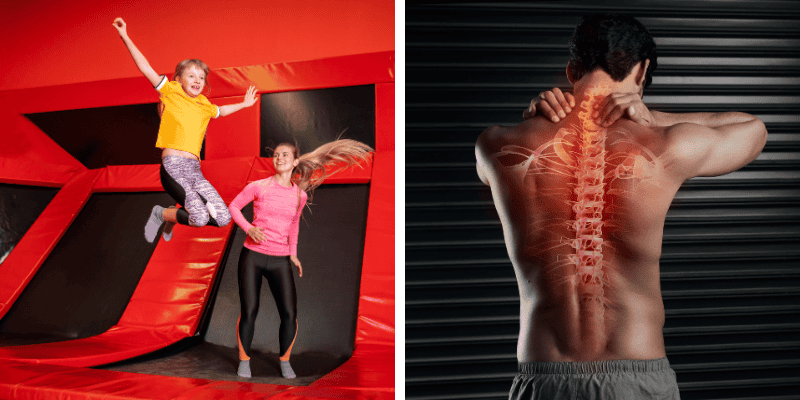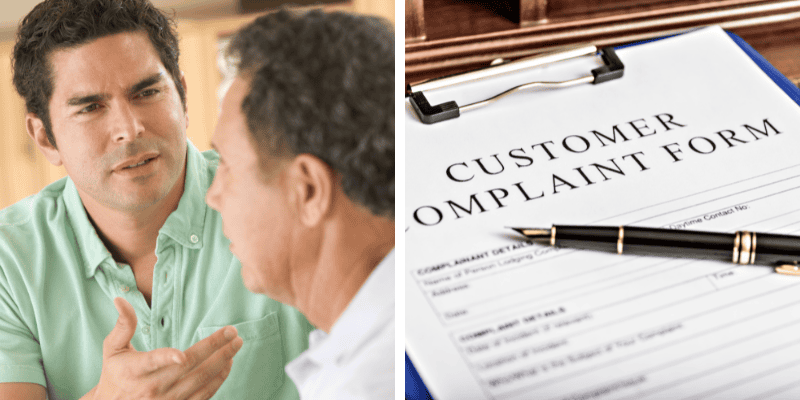4.9 Rating
Google REVIEWS
Leaders in Georgia Personal Injury Law Since 1995
Atlanta Trampoline Park Injury Lawyer
Safety Concerns for Kids and Trampoline Parks
Over the past several years, the Atlanta area has seen an increase in trampoline parks. At first glance, these indoor parks are especially fun for kids and teens. But as the popularity of these parks grow, there is an alarming statistic that is also increasing — that is, visits to the emergency room after a trampoline park injury. A recent Scientific American study suggests that the parks are not more dangerous than home trampolines, but the number of people using these parks has increased along with the number of injuries. And the way they are set up might increase the likelihood of injury and unfortunately for the business might result in a premise liability.
Atlanta and Georgia residents might recall a Fulton County trampoline park injury sustained by a child who went through many surgeries after his injury. Another very well known situation is the tragic incident several years ago in which a youth football coach was paralyzed from his shoulders down after a Georgia trampoline park injury. Jonathan Magwood’s injury resulted in legislation being introduced that would have added regulation and permit requirements for these parks. The legislation did not go very far and was not passed by the Georgia legislature. Mr. Magwood sued the park at which his injury was sustained.
The challenge for parents and caregivers who want their kids to have a safe and fun experience is found in the sobering statistic from the injury study about ER visits from trampoline parks. Between 2010 and 2014 there was a major increase in injuries that occurred at these facilities. And children from ages six to 17 are most vulnerable. As more and more of these parks open across the country, there is a growing concern about their safety backed up by data from this study. The research in this area looked only at injuries from the parks, not from gymnastics or sporting locations that provide more than wall to wall trampolines. The inherent danger in these parks are kids jumping in proximity to one another.

Most Common Types of Trampoline Park Injuries
The study looked at the types of injuries that most often occur at trampoline parks. The researchers found that for adults and for teenagers, sprains are the most common injuries. For children, fractures are the most common. The experts at the American Academy of Pediatrics has some suggestions for parents and caregivers. They say don’t let kids jump with multiple kids on a trampoline. This is important since many trampoline owners might not know not to allow kids to jump together; something lots of kids would want to do. Most injuries happen when there are multiple kids jumping on a trampoline or jumping close to one another at a park trampoline. The other important suggestions include making sure there is an adult present at all times and there is soft material to pad any falls. Additionally, the doctors advise that somersaults and flipping are not safe activities for kids.
Trampoline park injuries can be very serious. The owners of these facilities have a duty to protect you and your children, even if you sign a waiver that you know about the risks. There can still be situations in which, for example, the owner or employees have been negligent in keeping the equipment safe in various ways or have failed to deal with a dangerous condition.
If you, your child or teen was injured at a trampoline park due to the negligence or other safety issues, contact Scholle Law for a free evaluation of your situation. We will help you in any way we can and if you have a case, we do not get paid until you get paid.

Causes of Trampoline Park Injuries
Trampoline parks can be fun and exciting, but they also pose significant risks if proper safety measures are not in place. Injuries can occur due to several factors, many of which can be attributed to negligence or poor maintenance by the trampoline park. Below are the most common causes of injuries in trampoline parks:
Equipment Failure
- Poorly Maintained Trampolines: Trampolines require regular maintenance to ensure they are safe for use. Springs can wear out, mats can tear, and frames can become unstable over time. If a trampoline is not properly maintained, it may collapse or malfunction during use, leading to serious injuries such as fractures, sprains, or even head and spinal injuries.
- Defective Equipment: Sometimes, the equipment itself is faulty due to manufacturing defects. This could include poorly designed trampolines, safety nets that do not hold up under pressure, or padding that fails to protect jumpers from hard surfaces. In these cases, both the manufacturer and the trampoline park may be held liable for any injuries that result from the defective equipment.
Inadequate Supervision by Staff
- Lack of Staff Presence: Trampoline parks should have trained staff members monitoring the activities on the trampolines at all times. Their role is to ensure that participants are following the rules, using the equipment safely, and not engaging in risky behavior that could lead to injury. When there is insufficient supervision, children and adults alike may engage in unsafe practices, leading to avoidable accidents.
- Untrained or Underqualified Staff: Even when staff are present, if they are not properly trained or are unaware of the safety protocols, they may be unable to prevent accidents. Staff should be trained to spot potential hazards, intervene in unsafe behavior, and provide immediate assistance if an injury occurs.
Overcrowding and Unsafe Practices
- Excessive Number of Participants: Trampoline parks often operate at maximum capacity, especially during peak hours. When too many people are jumping on the trampolines simultaneously, the risk of collisions and falls increases dramatically. Overcrowding can make it difficult for individuals to maintain control over their movements, leading to serious accidents.
- Unsafe Jumping Practices: Unsafe practices, such as attempting flips without proper training, multiple people jumping on the same trampoline, or allowing young children to jump alongside much larger adults, significantly increase the risk of injury. Parks should enforce strict rules to prevent these dangerous behaviors, but often fail to do so.
Inadequate Safety Measures
- Lack of Padding: Proper padding is crucial to preventing injuries in trampoline parks. Padding should be placed around all hard surfaces, such as the trampoline frame, poles, and any nearby walls. Without sufficient padding, a fall or collision can result in severe injuries, including broken bones and head trauma.
- Insufficient Safety Nets: Safety nets are designed to catch participants who fall off the trampolines, preventing them from hitting the ground or other hard surfaces. However, if these nets are not properly installed, maintained, or are absent altogether, the risk of falling off the trampoline increases. A lack of safety nets or poorly maintained nets can result in serious injuries.
- Neglect of Safety Protocols: Trampoline parks should have strict safety protocols in place, including regular safety inspections, clear signage for safety rules, and enforced guidelines for participants based on age and skill level. When these protocols are neglected or ignored, the likelihood of accidents and injuries rises significantly.

Liability in Trampoline Park Accidents
When an injury occurs at a trampoline park, determining who is legally responsible—or liable—for the accident is crucial. Liability can involve multiple parties depending on the circumstances surrounding the injury. Below is an in-depth look at who can be held liable, how premises liability law in Georgia applies, the impact of waivers and liability releases, and strategies for challenging these waivers in court.
Who Can Be Held Liable?
- Park Owners: The primary responsibility for ensuring the safety of a trampoline park rests with its owners. Park owners are required to maintain a safe environment for their guests, which includes properly maintaining equipment, ensuring that safety protocols are followed, and providing adequate supervision. If the park owners fail to meet these obligations and an injury occurs as a result, they can be held liable for the damages.
- Equipment Manufacturers: If an injury is caused by a defective trampoline or other faulty equipment, the manufacturer of that equipment can also be held liable. This is particularly relevant if the injury resulted from a design flaw, manufacturing defect, or insufficient safety warnings. In such cases, the legal concept of product liability may apply, allowing the injured party to pursue compensation from the manufacturer.
- Third-Party Contractors: In some cases, trampoline parks may hire third-party contractors for specific tasks such as maintenance, safety inspections, or staffing. If a contractor’s negligence contributed to the injury—for example, by failing to properly inspect equipment or by providing unqualified staff—the contractor may share liability for the accident.
- Other Participants: In situations where one participant’s reckless or negligent behavior directly causes injury to another, that participant could potentially be held liable. However, this often depends on the specific circumstances of the incident and whether the trampoline park had sufficient supervision and rules in place to prevent such behavior.
Explanation of Premises Liability Law in Georgia
- Duty of Care: In Georgia, premises liability law requires property owners, including trampoline park owners, to exercise a reasonable level of care in keeping their premises safe for visitors. This duty of care includes regularly inspecting the property, repairing any hazards, and warning visitors of potential dangers. If a trampoline park owner breaches this duty and an injury results, they can be held liable for the damages.
- Invitees vs. Licensees vs. Trespassers: Georgia law distinguishes between different types of visitors. Most trampoline park guests are considered “invitees,” meaning they are on the property for the benefit of the owner (e.g., paying customers). Property owners owe the highest duty of care to invitees, which includes taking proactive steps to prevent injuries. The duty owed to licensees (non-paying guests) and trespassers is generally lower, but trampoline park owners can still be liable in certain circumstances, such as willful or wanton misconduct.
Discussion of Waivers and Liability Releases Signed by Participants
- Common Use of Waivers: Trampoline parks typically require participants (or their guardians) to sign liability waivers before using the facilities. These waivers are intended to protect the park from legal claims by asserting that participants assume the risk of injury and agree not to hold the park liable. The language in these waivers is often broad and can cover a wide range of potential injuries.
- Legal Enforceability: In Georgia, liability waivers are generally enforceable, but they are not absolute. Courts will scrutinize the language of the waiver, the circumstances under which it was signed, and whether it was clear and understandable to the average person. Additionally, waivers cannot excuse gross negligence or willful misconduct. If a waiver is found to be overly broad, ambiguous, or signed under duress, it may not hold up in court.
How to Challenge Liability Waivers in Court
- Proving Gross Negligence: One of the most effective ways to challenge a liability waiver is to demonstrate that the injury was caused by gross negligence on the part of the trampoline park. Gross negligence refers to a severe lack of care that shows a reckless disregard for the safety of others. If the court finds that the park’s conduct meets this threshold, the waiver may be deemed unenforceable, allowing the injured party to pursue compensation.
- Arguing Unconscionability: A waiver may also be challenged on the grounds of unconscionability, which occurs when the terms of the waiver are so unfairly one-sided that they shock the conscience. This can include situations where the waiver was presented in a take-it-or-leave-it manner, with no opportunity for negotiation, or where the participant was not given adequate time to read and understand the waiver before signing.
- Highlighting Ambiguity or Vagueness: If a waiver is ambiguous or vague in its wording, it may not be enforceable. Courts in Georgia may rule that the waiver does not clearly convey the rights being waived, especially if the language is difficult for an average person to understand. For example, if the waiver does not explicitly state that it covers injuries resulting from the park’s negligence, the court may decide that the waiver does not protect the park from liability.
- Questioning the Validity of the Agreement: In some cases, the circumstances under which the waiver was signed can be challenged. For instance, if a minor signed the waiver without parental consent, or if the waiver was signed electronically without proper verification, the court may rule that the agreement is invalid.

Steps to Take After a Trampoline Park Injury
If you or a loved one is injured at a trampoline park, the actions you take immediately following the accident are crucial for both your health and any potential legal claims. Taking the right steps can help ensure that you receive the necessary medical care and that your rights are protected if you decide to pursue compensation. Here’s a detailed guide on what to do after a trampoline park injury:
Seeking Immediate Medical Attention
- Importance of Prompt Care: The first and most important step after sustaining an injury is to seek immediate medical attention. Even if the injury appears to be minor, it’s essential to get evaluated by a healthcare professional. Some injuries, such as concussions, fractures, or internal injuries, may not be immediately apparent but can have serious long-term consequences if left untreated.
- On-Site Medical Response: If the trampoline park has on-site medical staff, seek their assistance right away. They can provide initial care and determine if emergency services are needed. If the injury is severe, call 911 or request that someone else do so immediately.
- Follow-Up Care: After receiving initial treatment, follow up with your primary care physician or a specialist as needed. Keep all medical appointments and adhere to prescribed treatments. This not only ensures your recovery but also creates a comprehensive medical record of your injuries, which can be critical in a legal claim.
Documenting the Scene
- Taking Photographs: If possible, take photos of the accident scene immediately after the injury occurs. Capture images of the specific trampoline or area where the injury happened, including any visible defects or hazards. Also, photograph any signs, warnings, or lack thereof, that might indicate negligence on the part of the park. If you have visible injuries, take clear photos of those as well.
- Gathering Witness Statements: If there were any witnesses to the accident, try to obtain their contact information and ask if they are willing to provide a statement. Witnesses can provide valuable third-party accounts of how the injury occurred, which can support your case. Be sure to record their statements as soon as possible while the details are still fresh in their minds.
- Noting Environmental Factors: Make note of any environmental conditions that might have contributed to the accident, such as poor lighting, overcrowding, or wet surfaces. Documenting these factors can help establish whether the park failed to maintain a safe environment.

Reporting the Incident to Park Management
- Filing an Incident Report: Report the injury to the park management as soon as possible. Most trampoline parks have a procedure in place for handling injuries, which usually involves filling out an incident report. Make sure the report accurately reflects what happened and that it includes all relevant details, such as the time, location, and nature of the injury.
- Obtaining a Copy of the Report: After the incident report is filed, request a copy for your records. This document can be critical evidence if you pursue a legal claim. If the park management refuses to provide a copy, make a note of the refusal and report it to your attorney.
- Avoiding Admittance of Fault: When speaking with park management, be cautious about what you say. Do not admit fault or speculate about the cause of the injury. Stick to the facts and let the investigation determine liability.
Preserving Evidence
- Keeping Copies of Medical Records: Collect and keep copies of all medical records related to your injury. This includes emergency room visits, doctor’s notes, test results, prescriptions, and any other documentation of your medical treatment. These records are vital in proving the extent and cause of your injuries.
- Retaining Accident Reports: In addition to the park’s incident report, you should also create your own written account of the accident as soon as possible. Include every detail you can remember, from what you were doing before the injury to how the park staff responded. This personal account can be valuable in corroborating other evidence.
- Preserving Physical Evidence: If the injury involved defective equipment (e.g., a broken spring or a torn trampoline mat), try to preserve this evidence. If you cannot take the physical item with you, take detailed photographs and note its location so that it can be inspected later.
- Documenting Expenses: Keep records of all expenses related to the injury, including medical bills, transportation costs to medical appointments, and any other financial losses incurred as a result of the accident. These expenses can be included in your claim for compensation.
Frequently Asked Questions
Can I sue a trampoline park if I signed a waiver?
Yes, you can still sue if you signed a waiver, especially if the injury was caused by gross negligence or if the waiver is found to be overly broad or unclear.
How much does it cost to hire a trampoline park injury lawyer?
Most personal injury lawyers work on a contingency fee basis, meaning you only pay if you win your case. The fee is typically a percentage of the settlement or award.
How long do I have to file a lawsuit after an injury?
In Georgia, you generally have two years from the date of the injury to file a personal injury lawsuit.
What should I do if my child is injured at a trampoline park?
Seek immediate medical attention, document the scene, report the incident to park management, and consult with an injury lawyer to discuss your legal options.
What if the injury was caused by another participant?
If another participant’s negligence caused the injury, you might be able to hold them, or the park for failing to enforce safety rules, liable.
Can I still file a claim if the injury was partially my fault?
Yes, you can still file a claim, but your compensation may be reduced based on your percentage of fault under Georgia’s comparative negligence law.
